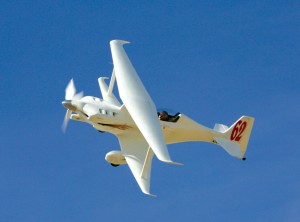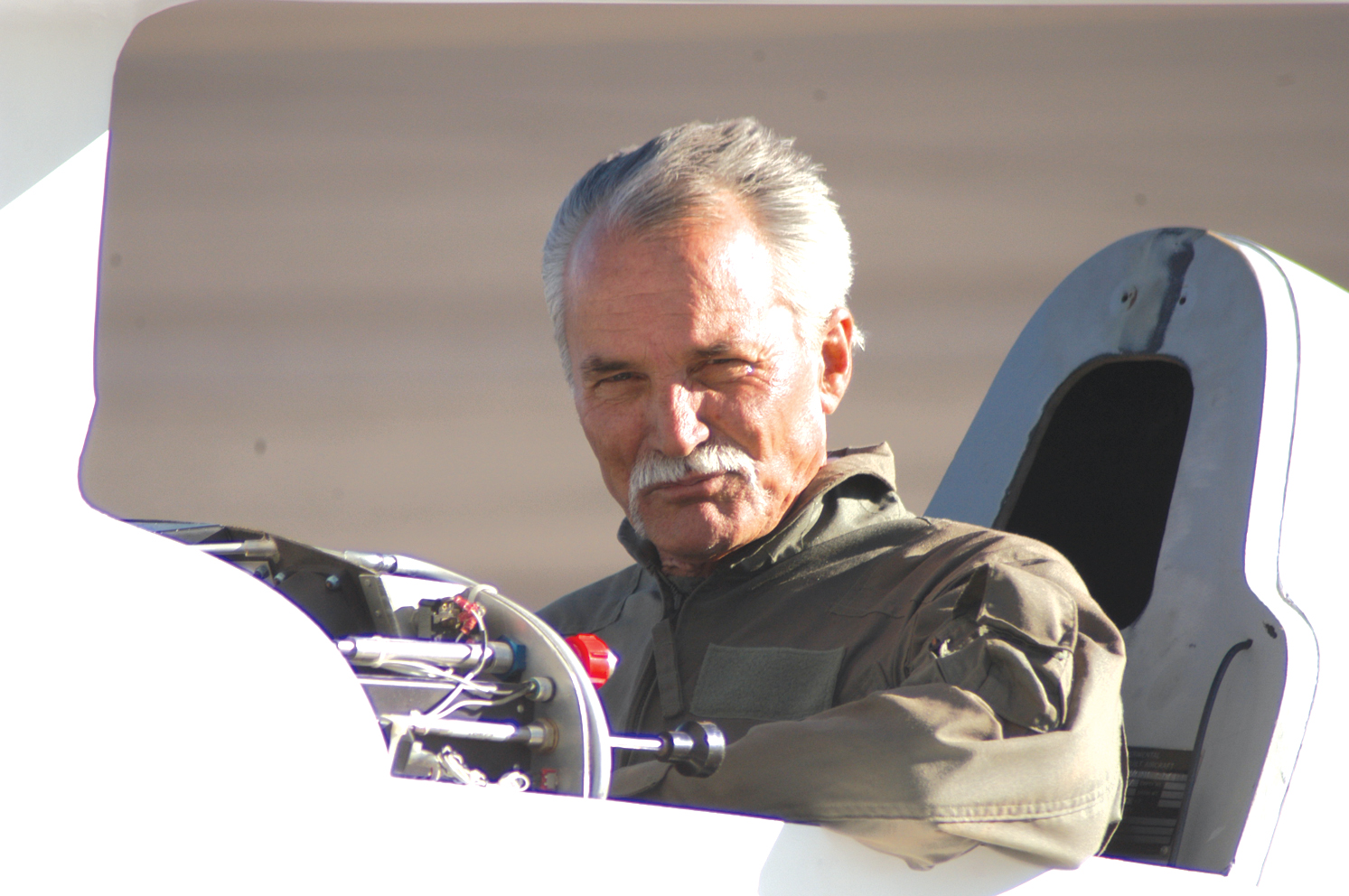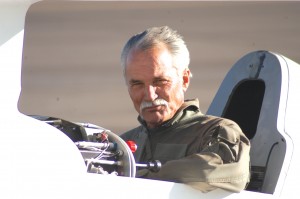By S. Clayton Moore
Tom Aberle can remember the early days of biplane racing when it was a struggle to pull an aircraft up above 130 miles per hour. It was an extraordinary achievement, then, when “Phantom,” his #62 biplane, won last year’s Biplane class race at Reno National Championship Air Races with a record-breaking speed of 241.534 miles per hour. The 62-year-old pilot’s historic race topped the old record of 225 miles per hour.
Aberle has been flying since childhood and racing at Reno since 1966. He’s a third-generation pilot and flying is a family trade. His father originally owned Alondra Flight Service on Compton Airport in Los Angeles. Aberle owns Aberle Custom Aircraft, a fabrication and maintenance shop based in the small community of Fallbrook, Calif., where his mother still owns Fallbrook Air Service, which rents out hangars to various aviation companies. Next door to Aberle, his son Jerry runs a maintenance shop.
“It’s really not legal to build airplanes in the experimental category, but quite often what does happen is that a guy starts building an airplane and runs into trouble of one sort or another,” Aberle explained. “That is where we step in with finalizing the machine.”
Aberle and a dedicated team of friends, partners and dreamers across Southern California custom built the Phantom in 2003. It weighs 738 pounds and its four-cylinder, 360-cubic-inch LyCon engine generates more than 250 horsepower.
It’s a completely unique machine, chopped together from flying experience, mechanical know-how and high-end avionics innovation. Its flight is the pinnacle of a racing career that started with the 1966 races at Stead Air Force Base and ran through wins at Reno in the late 1980s and 1990s.
“I’ve kept the flying aspect just for fun, meaning that I’ve never really worked at it,” Aberle said. “I can’t legally make money with a private certificate for flying. Racing is probably the one place where that rule goes out the window because it’s a prize, not a wage.”
He always intended to be a pilot, but at his father’s suggestion he earned his aircraft and power plant mechanic certificate from the Northrop Institute of Technology in Inglewood.
“A year later, I had my ticket in my pocket and started working on planes and just never stopped working on them,” Aberle said.
Early on, the young pilot was given a rare chance when Skip Hellen let Aberle take a shot at his custom-built, single-seat Starduster.
“Most people don’t get to fly a single-seat aircraft unless they buy it,” he said. “I certainly didn’t have the wherewithal to buy that airplane, but Skip put some faith in me and my professionalism and I got to fly it. That opened the door to a lot more single-seat airplanes.”
Air racing was just beginning again in the early 1960s and Tom Aberle wanted in. In 1966, the Reno Air Races moved out of the desert on its present site at Stead Air Force Base and Aberle got to fly the Starduster on the course.
“We hot-rodded the engine some, which was not blessed by the rules at the time, but we needed a few more miles per hour out of the engine,” Aberle said.
His racing career hasn’t stopped since, sending him racing not only in Reno, but also everywhere from St. Louis to Mexicali. A crunched Mong Sport biplane in the early 1980s forced a rebuild that reemerged as a prizewinner in the 1980s. Biplane champion Bill Boland told him, “You took an old dog and made it into a beautiful thing.”
The #31 “Long Gone Mong” was a hot aircraft at Reno in 1987, 1988 and 1989, winning two national championships. The plane was fast at the time, with a top speed of 206 mph, but drastically slower than Phantom.
“Very much like this past September, I showed up in a field of aircraft that were all at least five miles per hour slower,” Aberle said. “We got away from them pretty seriously in 1987, ran second plane in 1988, and in 1989, we were top qualifier and first plane as well.”
For all of its remarkable speed, Phantom was ironically imagined and assembled mostly on the fly. Aberle partnered with Seattle pilot Andrew Buehler, and the two started thinking about rebuilding a wrecked Mong Sport as early as 1991 but didn’t jump into full-fledged partnership until 2003.
They started building the aircraft that would become Phantom on Feb. 28, 2003, with backing from an enthusiastic sponsor. Although the sponsor is no longer in business, it was the spark that Phantom needed to get going.
“I showed the sponsor the stripped truss we were working with and he asked two questions: The first was, ‘Will it win?’ I was emphatic in saying yes,” he recalled. “The second was whether I could make it this year and my response was, ‘It’s possible.'”
Aberle also gathered help from a number of friends and colleagues including his son Jerry, Stewart and Andy Patterson of Patterson Motor Sports in Fallbrook and Robert T. Bush from Northrop Grumman, who conjured up many of the Phantom concepts.
It turned out to be more than possible. The plane first flew in late August 2003; by September, it was the top qualifier in its category at Reno with a speed of 221 miles per hour. It was a good year barring one major setback.
“We had two runs, both successful, and both near tragic,” Aberle said.
He laughed about destroying not one, but two propellers at Reno. Their standard two-blade prop started migrating on the prop extension, loosening up the bolts and creating a compounding problem. Although the team managed to scrape up another propeller, it started shredding at the wing tips. It was time to find another solution.
“The question has come to mind a few times since we damaged those propellers,” he said. “If conventional technology hadn’t twice failed us, would I have looked at an experimental propeller? My guess is no. The thing is so strange that in a way, it complements the airplane, which is unusual itself.”
He’s talking about the highly unusual solution offered up by aviation enthusiast Paul Lipps, who had seen an article about Phantom in Sportsman Pilot magazine. Lipps had developed an unusual propeller design for his own Lancair 235 and thought that that Phantom would benefit from a custom design.
“After a period of several months of conversations, we got three of the propellers that Paul had built,” he said. “He shipped us a two-blader and we mounted it and tested it. It was amazing. In racing, I had never experienced anything in the 200 mph realm that could boost my speed a further ten more miles per hour in one fell swoop.”

Tom Aberle won last year’s Biplane class race at Reno National Championship Air Races with a record-breaking speed of 241.534 miles per hour, in his Mong Sport, “Phantom.”
After analysis with a data acquisition system, the propeller was redesigned and tested in August 2004.
“We had maybe four flights on it when we took it to Reno, but that’s what got us to 240 miles per hour,” Aberle said.
With its first place win in the sport biplane class, the aircraft beat 26 others to win that division at Reno. It ran almost 20 mph faster than second-place finisher David Rose and over 30 mph than the third-place finisher.
“The acceleration is just blinding,” he said. “From the get-go, it will set your head back. The airplane flies at about 1,000 pounds in excess of 200 horsepower so you know it’s going to get with the program. About the time it gets off the ground, you feel the plane picking up and it accelerates really well all the way from 100 mph to 200 mph. Right now, it’s almost comparable to the conventional technology blade.”
Aberle and his team hope to hit around 250 mph at next year’s races. Its remarkable achievement rebuffs some of the comments directed at Phantom, the most common being that it might not be the most attractive aircraft in its field.
“That comment is borne out by the Reno Air Association’s website, which is noticeably lacking a photo of the record-breaking winner in the biplane class,” Aberle laughed.
Nevertheless, he’s come to appreciate the speedy biplane and is ready to race it again next year.
“I’m sitting here with the airplane 15 feet away and that’s how it is every day of my life,” Aberle reflected. “It took me damned near a year to look at it and see how it might be pretty, but it is unusual and it is striking. There sits my dream.”












